Abstract
The purpose of this study was to evaluate the hormonal control of pyloric sphincter function. Studies were performed on both pyloric circular muscle, in vitro, and the human pylorus, in vivo. Full dose-response curves to gastrin I, cholecystokinin, and secretin were constructed for the pyloric muscle of the opossum studied at its length of optimal tension development, Lo. Both cholecystokinin and secretin were potent agonists on the muscle but gastrin I gave no increase in muscle tension. The combination of cholecystokinin and secretin was additive at submaximal concentrations but potentiation of the maximal responses was not observed. Gastrin I produced a surmountable, competitive-like antagonism to the effect of cholecystokinin on the pyloric muscle. The octapeptide of cholecystokinin was a more potent agonist than the whole molecule of cholecystokinin on the pyloric muscle. In man, the pyloric pressure rose significantly during intravenous infusion of either cholecystokinin or secretin. The combination of maximal doses of both hormones did not show significant potentiation. Gastrin I did not significantly increase pyloric pressure but did antagonize the pyloric response to duodenal acidification. These studies suggest that: (a) Both secretin and cholecystokinin augment pyloric sphincter pressure while gastrin I is an antagonist inhibiting their effects. (b) The hormonal responses of pyloric sphincter circular muscle, in vitro, can be correlated with human sphincter function, in vivo.
Full text
PDF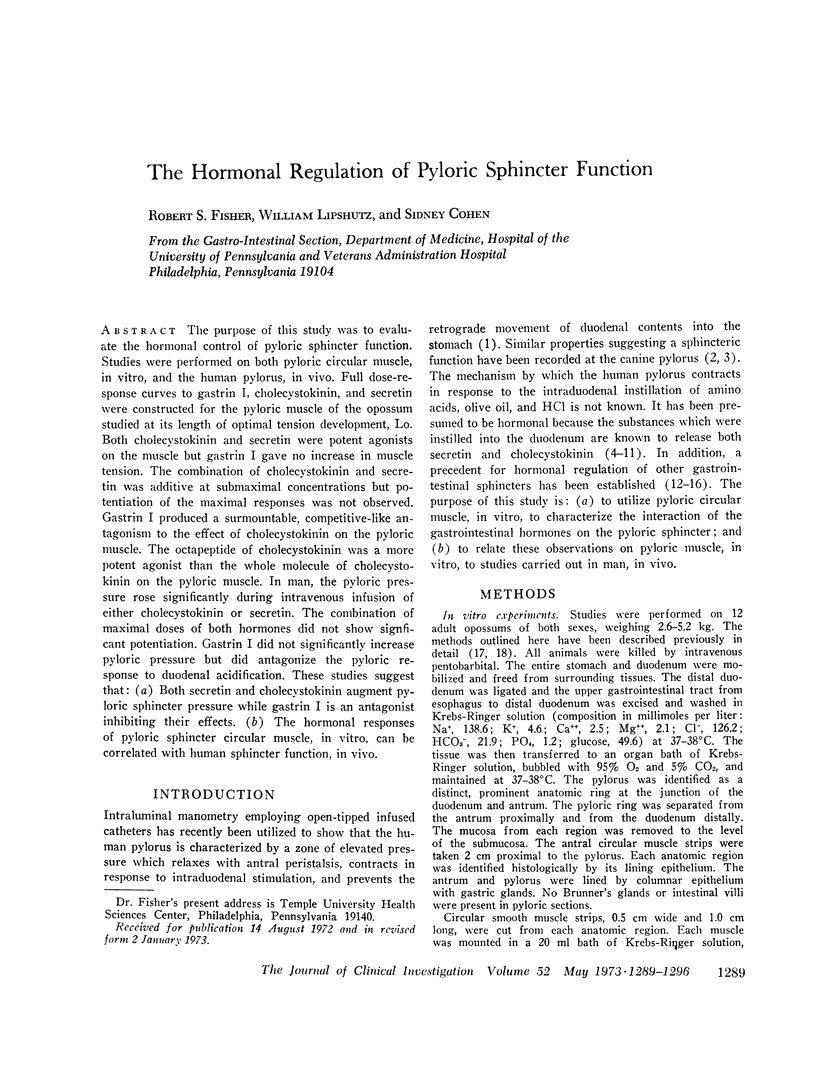
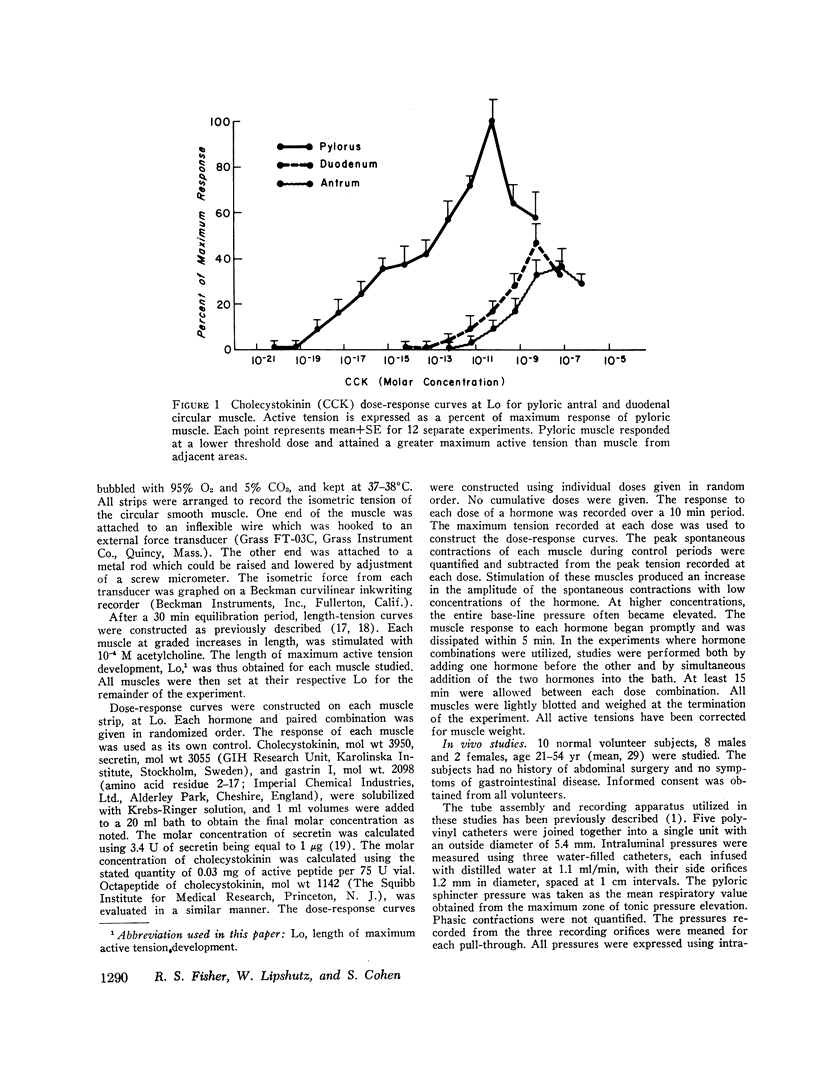
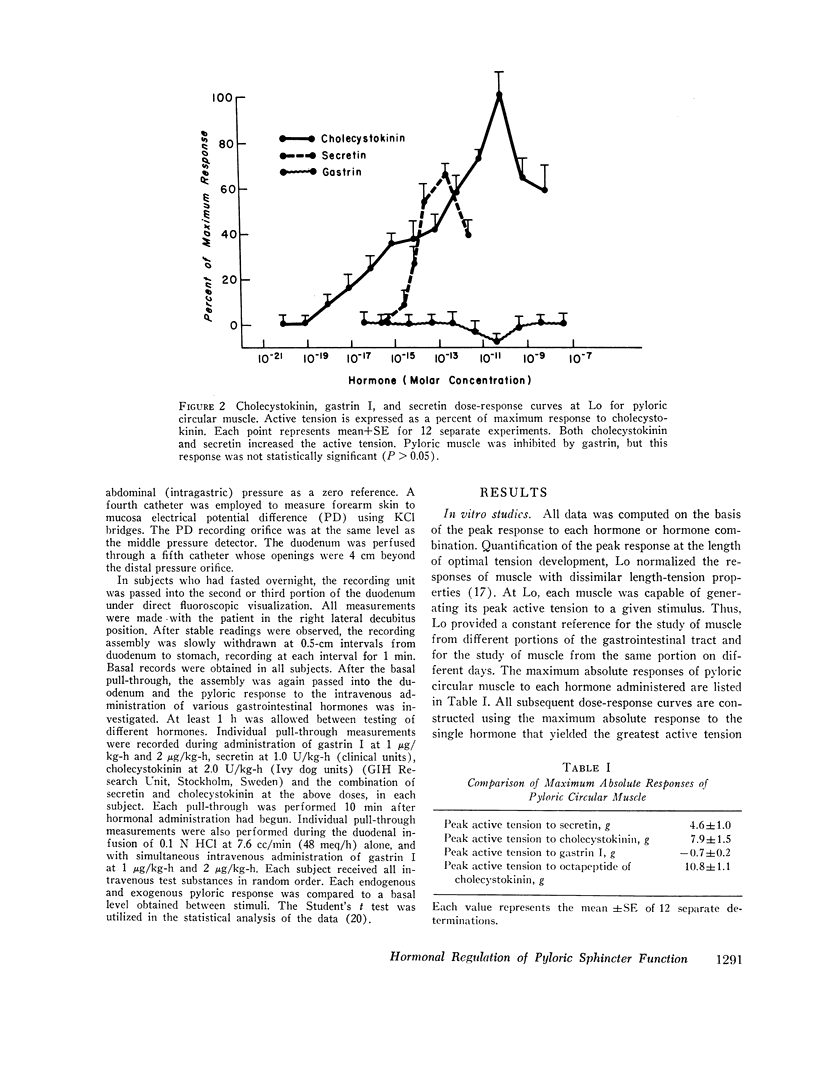
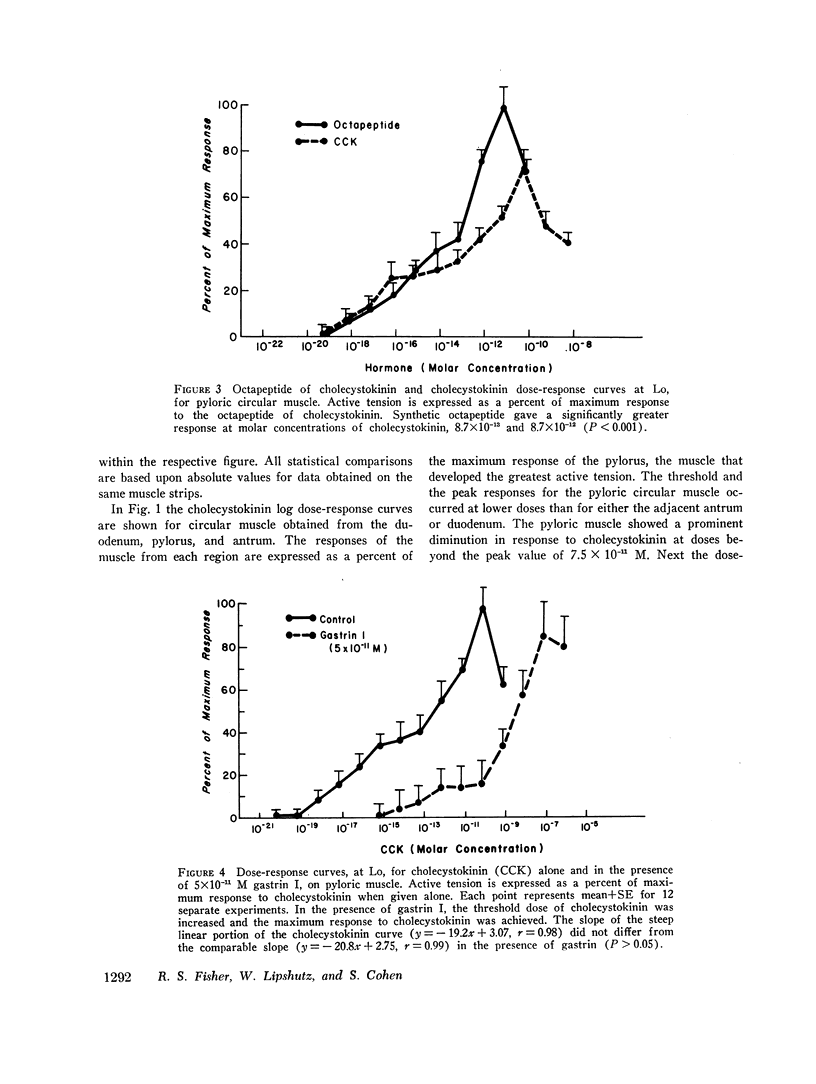
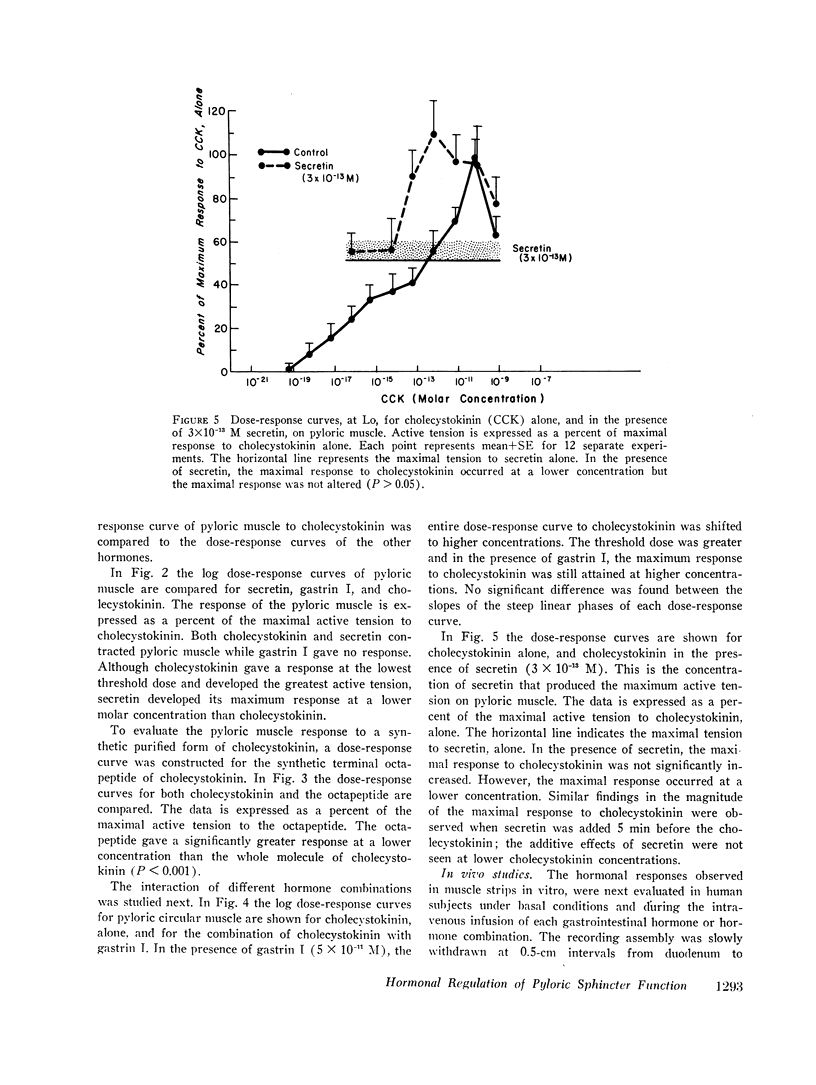
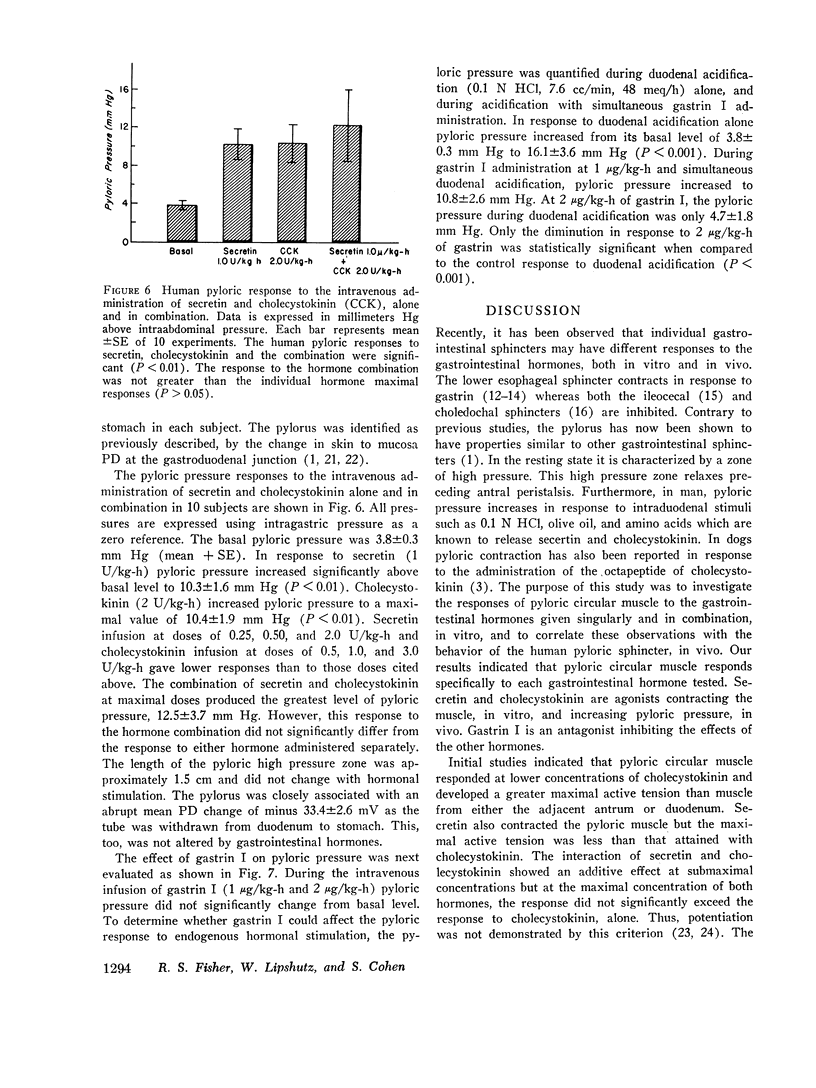
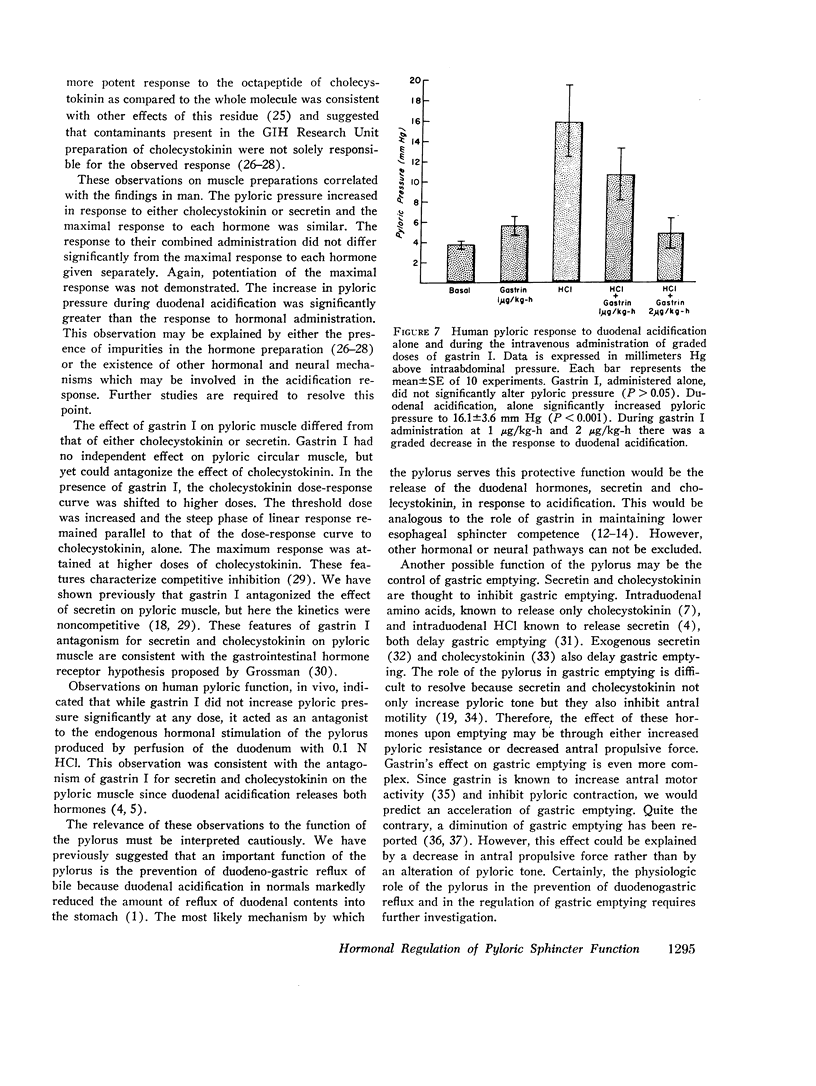
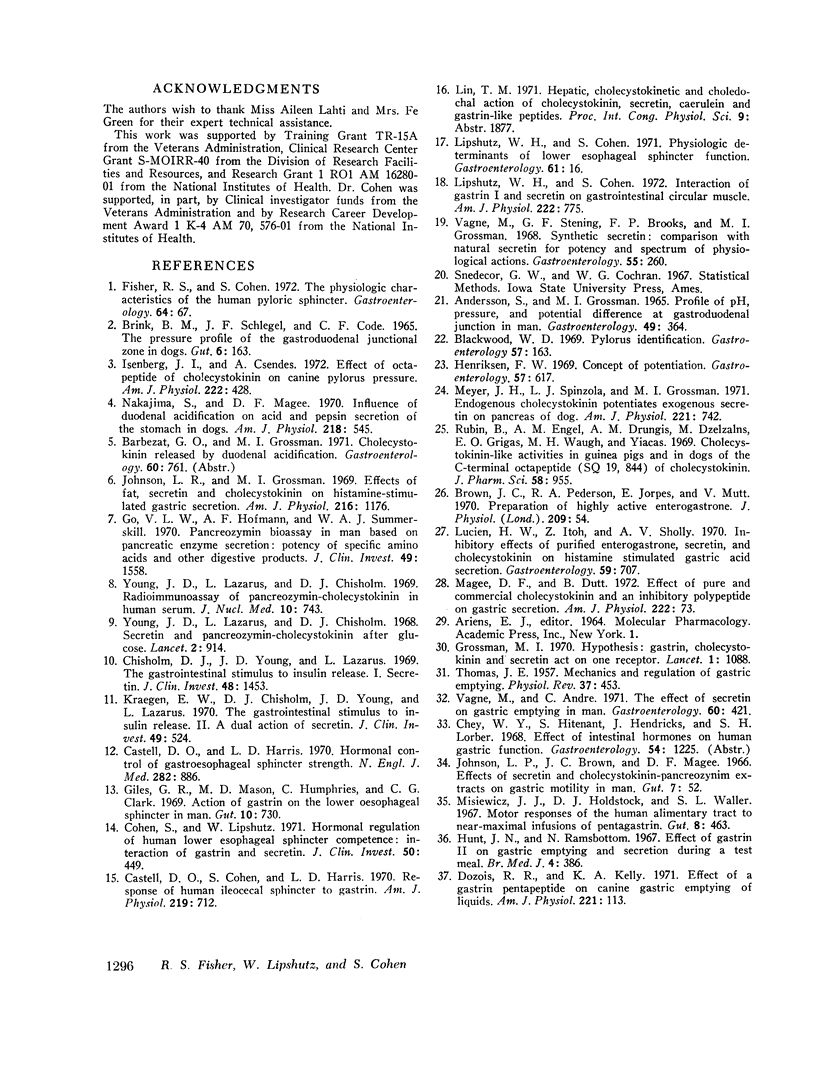
Selected References
These references are in PubMed. This may not be the complete list of references from this article.
- Andersson S., Grossman M. I. Profile of pH, pressure, and potential difference at gastroduodenal junction in man. Gastroenterology. 1965 Oct;49(4):364–371. [PubMed] [Google Scholar]
- BRINK B. M., SCHLEGEL J. F., CODE C. F. THE PRESSURE PROFILE OF THE GASTRODUODENAL JUNCTIONAL ZONE IN DOGS. Gut. 1965 Apr;6:163–171. doi: 10.1136/gut.6.2.163. [DOI] [PMC free article] [PubMed] [Google Scholar]
- Blackwood W. D. Pylorus identification. Gastroenterology. 1969 Aug;57(2):163–167. [PubMed] [Google Scholar]
- Castell D. O., Cohen S., Harris L. D. Response of human ileocecal sphincter to gastrin. Am J Physiol. 1970 Sep;219(3):712–715. doi: 10.1152/ajplegacy.1970.219.3.712. [DOI] [PubMed] [Google Scholar]
- Castell D. O., Harris L. D. Hormonal control of gastroesophageal-sphincter strength. N Engl J Med. 1970 Apr 16;282(16):886–889. doi: 10.1056/NEJM197004162821602. [DOI] [PubMed] [Google Scholar]
- Chisholm D. J., Young J. D., Lazarus L. The gastrointestinal stimulus to insulin release. I. Secretin. J Clin Invest. 1969 Aug;48(8):1453–1460. doi: 10.1172/JCI106111. [DOI] [PMC free article] [PubMed] [Google Scholar]
- Cohen S., Lipshutz W. Hormonal regulation of human lower esophageal sphincter competence: interaction of gastrin and secretin. J Clin Invest. 1971 Feb;50(2):449–454. doi: 10.1172/JCI106512. [DOI] [PMC free article] [PubMed] [Google Scholar]
- Dozois R. R., Kelly K. A. Effect of a gastrin pentapeptide on canine gastric emptying of liquids. Am J Physiol. 1971 Jul;221(1):113–117. doi: 10.1152/ajplegacy.1971.221.1.113. [DOI] [PubMed] [Google Scholar]
- Fisher R., Cohen S. Physiological characteristics of the human pyloric sphincter. Gastroenterology. 1973 Jan;64(1):67–75. [PubMed] [Google Scholar]
- Giles G. R., Mason M. C., Humphries C., Clark C. G. Action of gastrin on the lower oesophageal sphincter in man. Gut. 1969 Sep;10(9):730–734. doi: 10.1136/gut.10.9.730. [DOI] [PMC free article] [PubMed] [Google Scholar]
- Go V. L., Hofmann A. F., Summerskill W. H. Pancreozymin bioassay in man based on pancreatic enzyme secretion: potency of specific amino acids and other digestive products. J Clin Invest. 1970 Aug;49(8):1558–1564. doi: 10.1172/JCI106373. [DOI] [PMC free article] [PubMed] [Google Scholar]
- Grossman M. I. Gastrin, cholecystokinin, and secretin act on one receptor. Lancet. 1970 May 23;1(7656):1088–1089. doi: 10.1016/s0140-6736(70)92758-3. [DOI] [PubMed] [Google Scholar]
- Henriksen F. W., Way L. W. The concept of potentiation. Gastroenterology. 1969 Nov;57(5):617–622. [PubMed] [Google Scholar]
- Hunt J. N., Ramsbottom N. Effect of gastrin II on gastric emptying and secretion during a test meal. Br Med J. 1967 Nov 18;4(5576):386–387. doi: 10.1136/bmj.4.5576.386. [DOI] [PMC free article] [PubMed] [Google Scholar]
- Isenberg J. I., Csendes A. Effect of octapeptide of cholecystokinin on canine pyloric pressure. Am J Physiol. 1972 Feb;222(2):428–431. doi: 10.1152/ajplegacy.1972.222.2.428. [DOI] [PubMed] [Google Scholar]
- Johnson L. P., Brown J. C., Magee D. F. Effect of secretin and cholecystokinin-pancreozymin extracts on gastric motility in man. Gut. 1966 Feb;7(1):52–57. doi: 10.1136/gut.7.1.52. [DOI] [PMC free article] [PubMed] [Google Scholar]
- Johnson L. R., Grossman M. I. Effects of fat, secretin, and cholecystokinin on histamine-stimulated gastric secretion. Am J Physiol. 1969 May;216(5):1176–1179. doi: 10.1152/ajplegacy.1969.216.5.1176. [DOI] [PubMed] [Google Scholar]
- Kraegen E. W., Chisholm D. J., Young J. D., Lazarus L. The gastrointestinal stimulus to insulin release. II. A dual action of secretin. J Clin Invest. 1970 Mar;49(3):524–529. doi: 10.1172/JCI106262. [DOI] [PMC free article] [PubMed] [Google Scholar]
- Lipshutz W., Cohen S. Interaction of gastrin I and secretin on gastrointestinal circular muscle. Am J Physiol. 1972 Mar;222(3):775–781. doi: 10.1152/ajplegacy.1972.222.3.775. [DOI] [PubMed] [Google Scholar]
- Lipshutz W., Cohen S. Physiological determinants of lower esophageal sphincter function. Gastroenterology. 1971 Jul;61(1):16–24. [PubMed] [Google Scholar]
- Lucien H. W., Itoh Z., Schally A. V. Inhibitory effects of a purified enterogasterone, secretin, and cholecystokinin on histamine-stimulated gastric acid secretion. Gastroenterology. 1970 Nov;59(5):707–711. [PubMed] [Google Scholar]
- Magee D. F., Dutt B. Effect of pure and commercial cholecystokinin and an inhibitory polypeptide on gastric secretion. Am J Physiol. 1972 Jan;222(1):73–76. doi: 10.1152/ajplegacy.1972.222.1.73. [DOI] [PubMed] [Google Scholar]
- Meyer J. H., Spingola J., Grossman M. I. Endogenous cholecystokinin potentiates exogenous secretin on pancreas of dog. Am J Physiol. 1971 Sep;221(3):742–747. doi: 10.1152/ajplegacy.1971.221.3.742. [DOI] [PubMed] [Google Scholar]
- Misiewicz J. J., Holdstock D. J., Waller S. L. Motor responses of the human alimentary tract to near-maximal infusions of pentagastrin. Gut. 1967 Oct;8(5):463–469. doi: 10.1136/gut.8.5.463. [DOI] [PMC free article] [PubMed] [Google Scholar]
- Nakajima S., Magee D. F. Influences of duodenal acidification on acid and pepsin secretion of the stomach in dogs. Am J Physiol. 1970 Feb;218(2):545–549. doi: 10.1152/ajplegacy.1970.218.2.545. [DOI] [PubMed] [Google Scholar]
- Rubin B., Engel S. L., Drungis A. M., Dzelzkalns M., Grigas E. O., Waugh M. H., Yiacas E. Cholecystokinin-like activities in guinea pigs and in dogs of the C-terminal octapeptide (SQ 19,844) of cholecystokinin. J Pharm Sci. 1969 Aug;58(8):955–959. doi: 10.1002/jps.2600580810. [DOI] [PubMed] [Google Scholar]
- THOMAS J. E. Mechanics and regulation of gastric emptying. Physiol Rev. 1957 Oct;37(4):453–474. doi: 10.1152/physrev.1957.37.4.453. [DOI] [PubMed] [Google Scholar]
- Vagne M., Andre C. The effect of secretin on gastric emptying in man. Gastroenterology. 1971 Mar;60(3):421–424. [PubMed] [Google Scholar]
- Vagne M., Stening G. F., Brooks F. P., Grossman M. I. Synthetic secretin: comparison with natural secretin for potency and spectrum of physiological actions. Gastroenterology. 1968 Aug;55(2):260–267. [PubMed] [Google Scholar]
- Young J. D., Lazarus L., Chisholm D. J. Radioimmunoassay of pancreozymin cholecystokinin in human serum. J Nucl Med. 1969 Dec;10(12):743–745. [PubMed] [Google Scholar]
- Young J. D., Lazarus L., Chisholm D. J. Secretin and pancreozymin-cholecystokinin after glucose. Lancet. 1968 Oct 26;2(7574):914–914. doi: 10.1016/s0140-6736(68)91081-7. [DOI] [PubMed] [Google Scholar]


